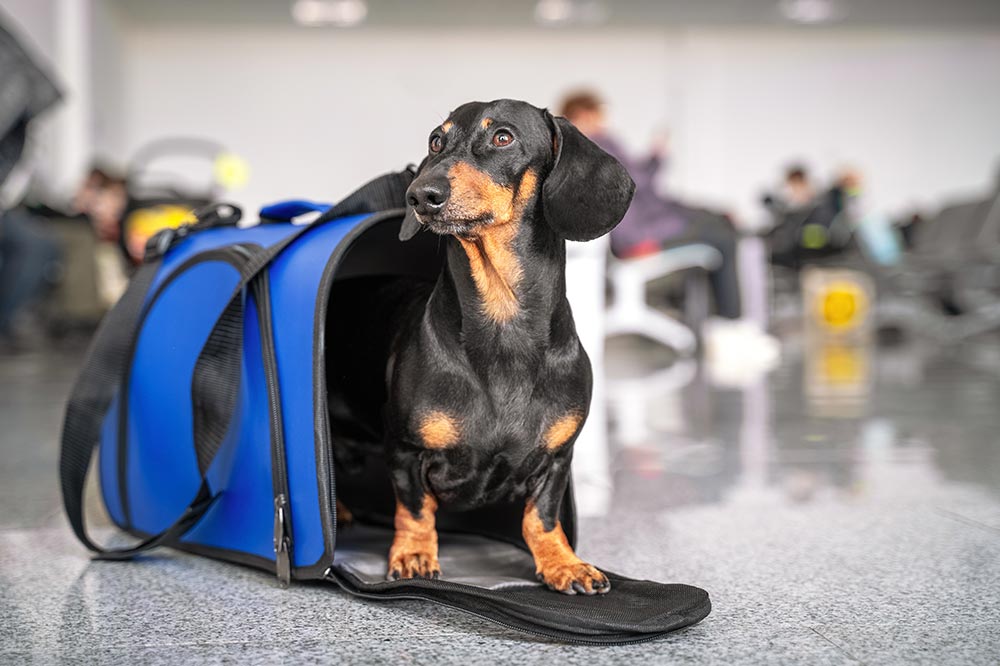Traveling with your pet can be a fun and memorable experience, but it requires careful planning and consideration to make the trip safe and stress-free. Whether you’re driving to a nearby beach or flying across the country, preparation makes all the difference. In this blog, we’ll explore essential pet travel tips to help you feel confident before you hit the road (or the skies) with your dog or cat. From travel safety gear to documentation and destination considerations, this blog covers what you need to know. If you have questions about traveling with your pet, call Midshore Veterinary Service in Easton, MD to schedule an appointment at (410) 820-9229.

Know Your Pet’s Travel Personality
Before you start booking hotels or packing bags, think about how your pet handles new experiences. Some pets enjoy being on the move, while others may struggle with travel-related stress or motion sensitivity.
Assess Your Pet’s Comfort Level
Not every animal is suited for long-distance travel. Does your pet handle car rides calmly? Can they settle down in unfamiliar settings, or do they become anxious? Take a few shorter trips leading up to your larger travel plans to gauge how your pet reacts. These “trial runs” can help you identify any behaviors or reactions that may need to be addressed before a longer journey.
Consider Alternatives for Anxious Pets
If your pet shows signs of travel stress such as vocalizing, drooling, shaking, or refusing to eat, it may be best to make other arrangements. Boarding facilities or pet sitters can offer a lower-stress solution if travel isn’t the best option for your companion. If you’re unsure, your veterinarian can help you determine what’s safest and most appropriate based on your pet’s behavior history.
Research Your Destination’s Pet Policies
Not all destinations are equally pet-friendly, so it’s important to know what to expect before you arrive. Thorough planning can save time, money, and unnecessary stress.
Pet-Friendly Accommodations
Call ahead or use pet-specific travel websites to confirm whether your hotel or vacation rental allows pets. Some places have restrictions based on size, breed, or species. Others may charge additional pet fees or require specific documentation.
Local Leash Laws and Area Restrictions
Check your destination’s leash laws and regulations for public spaces. Even pet-friendly locations often have rules about where pets can go and how they must be restrained. Researching in advance will help you avoid unexpected issues during your trip.
Veterinarian Access and Emergency Clinics
Make a list of local veterinary hospitals near your destination. Save their contact information in your phone, just in case you need assistance while you’re away. This is especially helpful for longer trips or unfamiliar locations.
Prepare Proper Travel Gear
Bringing the right equipment can make traveling with your pet more manageable and comfortable for both of you. Think safety, convenience, and cleanliness when packing.
Use a Secure Crate or Carrier
Crates and carriers help keep your pet safe during travel, especially in the car or on a plane. Choose one that’s appropriately sized and well-ventilated. Your pet should be able to stand up, turn around, and lie down comfortably inside.
Pack a Travel Bag for Your Pet
Stock a travel bag with essentials: food, bottled water, collapsible bowls, waste bags, leashes, a favorite toy or blanket, and any daily medications. Having everything in one place helps you stay organized during the trip.
ID Tags and Microchip Info
Before you leave, make sure your pet’s ID tags are updated with your current phone number. If your pet is microchipped, verify that your contact information is current in the microchip registry. This adds an extra layer of protection in case your pet gets separated from you while traveling.
Plan for Safe Car Travel
Traveling by car is one of the most common ways to bring pets along. While it offers flexibility, it still requires preparation to make the ride safe and comfortable.
Secure Your Pet While Driving
For your safety and theirs, pets should be secured while the vehicle is in motion. A crash-tested pet seatbelt harness, crate, or car barrier can help reduce the risk of injury in an accident. Loose pets can become dangerous distractions and may be at risk if airbags deploy.
Make Regular Stops
Plan to stop every 2–3 hours so your pet can stretch, drink water, and relieve themselves. Always use a leash when letting your pet out of the vehicle, even in quiet areas or rest stops.
Never Leave Your Pet in a Parked Car
Even on mild days, temperatures inside a parked vehicle can rise quickly and put your pet’s life at risk. If you’re stopping for a meal or break, choose places with outdoor seating or drive-through options where your pet can stay with you.
Air Travel Requirements for Pets
Flying with a pet involves strict regulations and more complex planning. Make sure you understand your airline’s policies before booking./p>
Know the Rules for Cabin vs. Cargo
Most airlines allow small pets to travel in the cabin, as long as they stay in an approved carrier under the seat. Larger pets may need to fly in the cargo hold, which has different requirements and considerations. Research thoroughly, and talk to the airline before booking to ensure compliance.
Health Certificates and Documentation
Many airlines require a current health certificate from a licensed veterinarian, dated within 10 days of your travel date. International travel may also require proof of vaccinations, import permits, and quarantine arrangements. Check with both your airline and destination to verify all necessary documents.
Direct Flights and Weather Considerations
Whenever possible, book direct flights to limit your pet’s time in transit. Avoid flying during extreme temperatures as heat and cold can be dangerous, especially for brachycephalic (short-nosed) breeds.
Create a Travel Routine for Your Pet
Sticking to a routine helps reduce your pet’s stress in unfamiliar settings. Consistency in feeding, bathroom breaks, and sleep can help your pet adjust more smoothly.
Keep Meal Times Consistent
Feed your pet at their usual times, even while on the road. Use bottled water to reduce the risk of digestive upset from changes in local water sources. Avoid feeding just before departure to minimize the risk of nausea.
Recreate a Familiar Sleeping Area
Bring your pet’s favorite bed or blanket to help them feel more secure at your destination. Familiar smells and textures can ease anxiety and encourage rest, especially at night.
Exercise and Mental Stimulation
Plan time for daily walks and interactive play. This helps your pet release energy and reduces the chances of restlessness or destructive behavior in unfamiliar environments.
Signs It’s Time to Call Midshore Veterinary Service
Even with the best preparation, unexpected questions can come up. If you’re planning a trip and need guidance specific to your pet’s needs, the team at Midshore Veterinary Service in Easton, MD is here to help. They can assist with travel health certificates, microchip registration checks, and recommendations for travel gear. Call (410) 820-9229 to speak with a team member or schedule a pre-travel appointment. With the right approach and expert support, your next trip can be an enjoyable experience for both you and your pet.
Recent Posts
About Us
At Midshore Veterinary Service, we don’t just care for animals—we care for the people who love them. Since 1994, we’ve strived to be the go-to veterinary hospital for cats, dogs, farm animals, and exotic pets in Easton, MD, and the surrounding areas.
